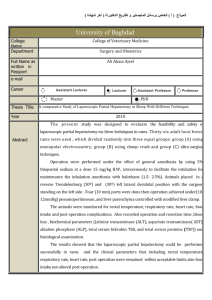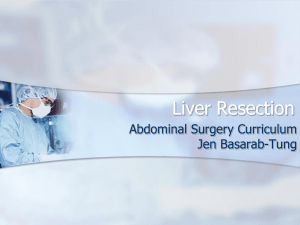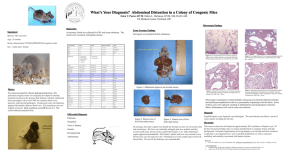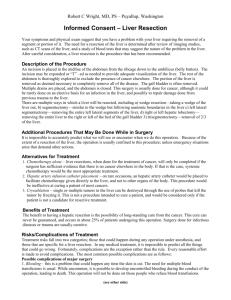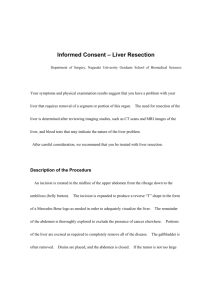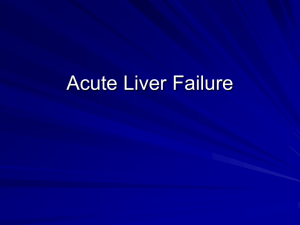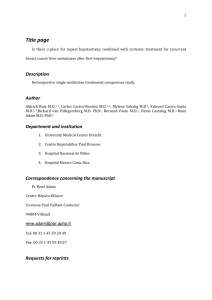The role of Pericystectomy for Hydatid Cysts of the
advertisement
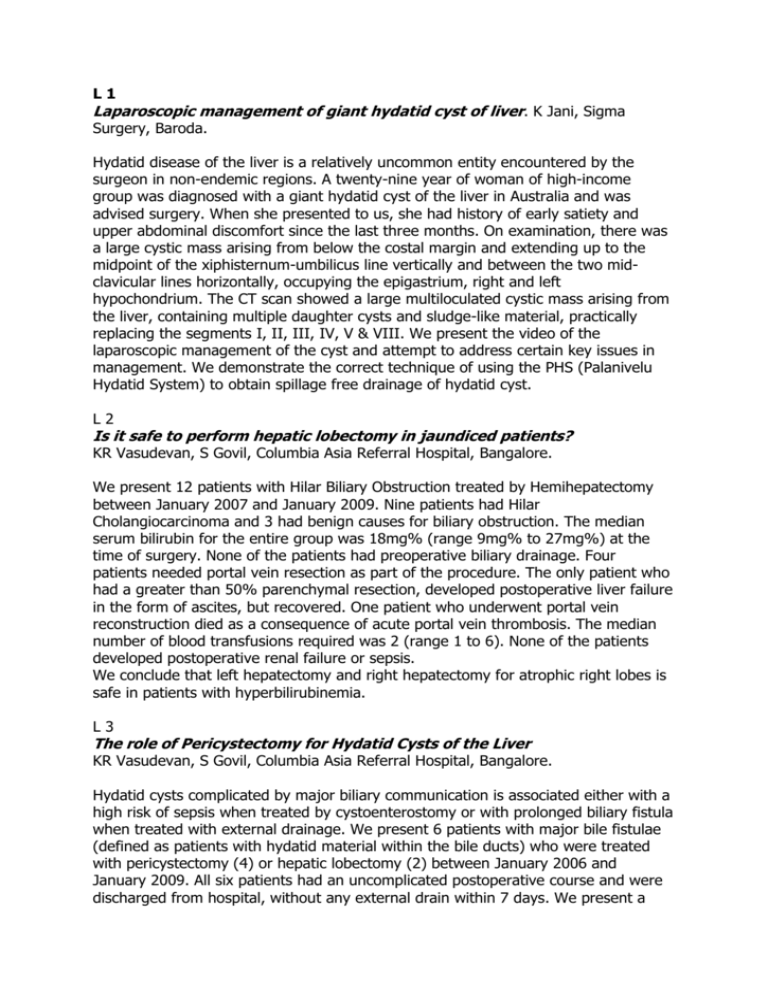
L1 Laparoscopic management of giant hydatid cyst of liver. K Jani, Sigma Surgery, Baroda. Hydatid disease of the liver is a relatively uncommon entity encountered by the surgeon in non-endemic regions. A twenty-nine year of woman of high-income group was diagnosed with a giant hydatid cyst of the liver in Australia and was advised surgery. When she presented to us, she had history of early satiety and upper abdominal discomfort since the last three months. On examination, there was a large cystic mass arising from below the costal margin and extending up to the midpoint of the xiphisternum-umbilicus line vertically and between the two midclavicular lines horizontally, occupying the epigastrium, right and left hypochondrium. The CT scan showed a large multiloculated cystic mass arising from the liver, containing multiple daughter cysts and sludge-like material, practically replacing the segments I, II, III, IV, V & VIII. We present the video of the laparoscopic management of the cyst and attempt to address certain key issues in management. We demonstrate the correct technique of using the PHS (Palanivelu Hydatid System) to obtain spillage free drainage of hydatid cyst. L2 Is it safe to perform hepatic lobectomy in jaundiced patients? KR Vasudevan, S Govil, Columbia Asia Referral Hospital, Bangalore. We present 12 patients with Hilar Biliary Obstruction treated by Hemihepatectomy between January 2007 and January 2009. Nine patients had Hilar Cholangiocarcinoma and 3 had benign causes for biliary obstruction. The median serum bilirubin for the entire group was 18mg% (range 9mg% to 27mg%) at the time of surgery. None of the patients had preoperative biliary drainage. Four patients needed portal vein resection as part of the procedure. The only patient who had a greater than 50% parenchymal resection, developed postoperative liver failure in the form of ascites, but recovered. One patient who underwent portal vein reconstruction died as a consequence of acute portal vein thrombosis. The median number of blood transfusions required was 2 (range 1 to 6). None of the patients developed postoperative renal failure or sepsis. We conclude that left hepatectomy and right hepatectomy for atrophic right lobes is safe in patients with hyperbilirubinemia. L3 The role of Pericystectomy for Hydatid Cysts of the Liver KR Vasudevan, S Govil, Columbia Asia Referral Hospital, Bangalore. Hydatid cysts complicated by major biliary communication is associated either with a high risk of sepsis when treated by cystoenterostomy or with prolonged biliary fistula when treated with external drainage. We present 6 patients with major bile fistulae (defined as patients with hydatid material within the bile ducts) who were treated with pericystectomy (4) or hepatic lobectomy (2) between January 2006 and January 2009. All six patients had an uncomplicated postoperative course and were discharged from hospital, without any external drain within 7 days. We present a further two patients with what we considered to be minor bile leaks that were treated in standard fashion who debeloped symptomatic recurrent bile cysts that subsequently needed pericystectomy to eradicate the cyst. We conclude that Pericystectomy/Lobectomy is the treatment of choice for hydatid cysts complicated by major bile communications. The threshold for performing pericystectomy for lesser degrees of biliary communication is unclear L4 Difficulties with staging Hepatocellular carcinoma in Cirrhotics KR Vasudevan, S Govil, Columbia Asia Referral Hospital, Bangalore. Preoperative staging for Hepatocellular Carcinoma in Cirrhotics is an imprecise art with different centres around the world using a wide variety of modalities. We present 7 cirrhotic patients with hepatocellular carcinoma who were operated by us between May 2008 and May 2009. These included two lobectomies, and 5 segmental resections (4 performed laparoscopically). We began staging with Triple-phase CT Abdomen including lower chest, Chest X-ray and Bone scan and have progressively changed to Quadruple-phase CT abdomen, CT chest and PET scan. Prior to resection patients also had intraoperative ultrasound. Even in this small group of patients we have found fallacies in interpretation of IOUS and PET scan in particular. Even shortterm survival has depended largely, though not exclusively, on postoperative histology. Five of seven patients are alive and tumour free at short follow-up of between 3 and 9 months. L5 Management of uncomplicated liver abscess- a prospective study comparing drugs alone versus drugs and aspiration. KA Khan, A Sinha, AS Rao, K Vani, VMMC & Safdarjang Hospital, New Delhi. Liver abscess is a common condition in India, and is associated with high morbidity and mortality. The literature tells us that the smaller amoebic liver abscesses can be treated conservatively, while the larger ones require intervention in the form of either closed or open drainage. However there is no clear cut consensus for the management of uncomplicated, symptomatic, medium sized ALA. The present study,conducted in the Department of General Surgery and Radio-diagnosis, VMMC and Safdarjang Hospital, New Delhi was an effort to establish an objective criteria for management of such abscesses. It was a prospective study of 106 cases of amoebic liver abscess (ALA) out of which,47 patients were identified and selected in the study group with abscess size ranging from 4cm to 8cm. The Study Group (n=47) was further subdivided into Study Group I (n=26) comprising of those patients who were treated with antiamoebic drugs alone and Study Group II (n=21) in whom ultrasound guided needle aspiration of the abscess was done in addition to antiamoebic drugs. The patients were examined daily for clinical improvement and they were followed up regularly till at least six weeks and repeat ultrasound examinations were done to assess the size of the abscess cavities. Our study clearly proved that in the treatment of uncomplicated amoebic liver abscess of medium size (4cm to 8cm), needle aspiration leads to significant decrease in subjective symptoms such as pain as well as early decrease in size of abscess cavity at 72 hours, however, there is no significant change observed in the long term resolution of abscess cavities at 6 weeks than in patients managed conservatively. L6 Microbubble Technology with Intra-Operative Ultrasound Improves The Detection Of Hepatic Lesions In Colo-Rectal Cancer. AJ Shah, MC Callaway, IM Pope, MG Thomas, Finch-Jones, Bristol Royal Infirmary, UK. Background: Around 60% of patients with colorectal cancer (CRC) develop liver metastases . Despite of advanced pre-operative imaging modalities like a multislice CT scan , many hepatic lesions are undetected or mis-diagnosed. The aim of our study was to determine whether microbubble (MB) contrast coupled with intraoperative ultrasound (IOUS) improved the detection of hepatic lesions in patients with Colorectal cancer. Methods: Two prospective single centre studies with regional ethics committee approval. Study I: To compare MB-IOUS against IOUS and a multislice computerised tomography (CT) in detecting hepatic lesions in patients undergoing primary CRC surgery. Study II: To compare MB-IOUS against IOUS and CT in the detection and characterisation of lesions in patients undergoing a hepatic resection for known liver metastases. Results: Study I: In the first prospective study of its kind, unenhanced scanning picked up additional lesions in 6 of the 21 patients studied. Microbubbles defined the characteristic of the lesion in all 6 patients and changed staging/management in 4/6 patients. Study II : Of the 32 patients recruited till date, the combination of microbubbles with IOUS changed management in 15 % of patients either by altering the operative intervention or predicting unresectability. Conclusion: In this novel study , microbubbles altered the staging and management of colorectal cancer in a significant number of patients. The findings of this study may ( if reproduced in other prospective trials) make a impact on the future investigation and management of patients with colorectal cancer. L7 Perioperative Outcomes and Factors predicting morbidity and mortality after Hepatectomy : A prospective study. P Senthil Kumar, V Vimalraj, R Sukumar, G Rajarathinam, E Selvakumar, GS Prabudoss, D Jyotibasu, Rajendran, R Surendran, Stanley Medical College, Chennai. Introduction and objectives: Evolution of surgical techniques in partial hepatectomy has enabled the procedure to be performed with operative mortality rate of less than 5% in high-volume centers in recent years. The current study aims to analyze the trends in perioperative outcome of 200 consecutive patients with hepatectomy for various benign or malignant hepatobiliary diseases in a specialized hepatobiliary center. Material and Methods: Between June 2004 to May 2009, 200 consecutive patients underwent hepatic resection for benign or malignant hepatobiliary diseases. To analyze the trends in perioperative variables and outcome of hepatectomy in our institution over the 5 year study period, Pre-, intra-, and postoperative data were recorded prospectively in a computerized database and analysed. Results: 115 men and 85 women underwent hepatectomy for benign or malignant hepatobiliary diseases. The mean age was 47.1 years [14 – 82 years]. 77% underwent major hepatic resection. The overall morbidity and hospital mortality of the 200 patients were 20% (n _ 40) and 3 % (n _ 6), respectively. The mean hospital stay was 16.2 (10 – 40) days. Concomitant comorbid illness, hyperbilirubinemia, hypoalbuminemia, prolonged prothrombin time, major hepatic resection, concomitant extra hepatic procedure, Pringles maneuver, blood loss of more than1 L, need for perioperative blood transfusion and fresh frozen plasma more than six units and presence of intraoperative hypotension were associated with increased morbidity, whereas presence of comorbid illness, prolonged prothrombin time, concomitant extra hepatic procedures and operative blood loss of more than 1 litre, was associated with increased hospital mortality. Conclusion: Reduced perioperative blood loss hence reduction in transfusion requirement is a main contributory factor for the improved outcome, and further effort should be directed toward improving surgical techniques to achieve bloodless hepatic resection. L8 Ruptured Liver Tumors : outcomes of a multidisciplinary approach. R Prabhakaran, V Vimalraj, R Sukumar, G Rajarathinam, E Selvakumar, GS Prabudoss, D Jyotibasu, Rajendran, R Surendran, Stanley Medical College, Chennai. Background: Spontaneous rupture of hepatic tumors is a life-threatening event. The aim of this study was to report a single center experience of patients with ruptured liver tumors. Materials and Methods: A retrospective review was performed of all patients who presented with ruptured HCC between 1999 and 2008. Data on clinical features, treatment strategies, and survival outcomes were collected. Results: A cohort of 24 patients (18 male and 6 female) was identified. The median age at presentation was 48 years. 21 patients had malignant tumors, 3 patients had benign lesions . Initial bleeding control was attempted by transarterial embolization (TAE) in 8 (33%) and it was successful in 7 patients. surgery was the primary modality of management in 16 patients . The procedures performed were Rt hepatectomy in 3 , Lt hepatectomy in 3 patients, Lt lateral segmentectomy in 2 cases, non anatomical resection in 2 patients and segmentectomy in 1. Hepatic artery ligation was done in 2 and perihepatic packing in 2 patients. Morbidity observed were bile leak in 2, intra abdominal sepsis in 2,Pulmonary complications in 2 and posthepatectomy liver failure in 1. Mean hospital stay was 14 days.(10 to 28days.).8/24(33.3%) died. |The causes of death were Coagulopathy in 4 patients, sepsis in 3 and post hepatectomy liver failure in 1. Conclusion: Ruptured liver lesions is a life threatening event and requires a multidisciplinary approach. Primary hemostasis, followed by emergency or staged hepatic resection, is the treatment of choice. Patients who had no underlying liver disease had better prognosis than those who had cirrhosis. L9 Surgery for pediatric liver tumours. SR Shah, S Motiwale, R Ramadwar, P Shroff, S Almel, PD Hinduja Hospital and Medical Research Center, Mumbai. Background: Liver tumours in children are rare and often need adjuvant chemotherapy. Aim: To audit the results of surgery for pediatric liver tumours. Methods: Retrospective study of 7 consecutive children subjected to resection for liver tumours, (age range 1 month- 14 years, median age 2 years), 4 with hepatoblastoma, one embryonal sarcoma, one focal nodular hyperplasia and one hepatocellular casncer. Three of the four patients with hepatoblastoma were subjected to neoadjuvant chemotherapy and all hepatoblastomas and the patient with embryonal sarcoma were subjected to adjuvant therapy. Results: There was no mortality. One child had subacute intestinal obstruction treated conservatively. All are currently alive and disease free at a median follow up of 3 years (range 1-8 years). Conclusions: The prognosis of resectable pediatric liver tumours is excellent. L 10 Laparoscopic liver resection. C Palanivelu, R Ravindran, P Senthilnathan, A Ramanujam, PS Rajan, Gem Hospital, Coimbatore. Aim: Liver resection is considered as one of the most formidable surgeries and laparoscopic resections for the same is considered as the last frontier in laparoscopy. In our video we would demonstrate the feasibility of laparoscopic liver resections emphasizing the excellent morbidity profile. Methods: Since 2006 we have performed 54 laparoscopic liver resections for malignant and non malignant diseases in normal and child A chirrotics, 8 were right hepatectomy, 18 left hepatectomies, 5 radical cholecystectomies and 23 were wedge / segmental resections .Surgery starts with the control and ligation of the vessels and the biliary ducts in cases of major resections. Parenchymal division is then started after the vascular demarcation using ultrasonic shears or monopolar electrocautery. CUSA is used for the parenchymal disruption. Small vessels are sealed and divided with bipolar and ultrasonic shears. Medium vessels and bile ducts are clipped and divided. Vascular staplers are used on the hepatic veins. Initially we used hand port to assist in dissections. Nowadays we don’t use hand port and the specimen is extracted in an endobag through a pfannensteil incision. No vascular isolation technique was used in any of the cases. Results: Mean operative time for major resections is 170 minutes and blood loss 190 ml. Blood transfusion was necessary in 9 cases. Mean hospital stay was 6 days. Four patients developed ascitis with pleural effusion and two developed significant bile leak which was managed conservatively in one and other had ERCP and stenting done. Conversion to open surgery was done in one case of right hepatectomy due to bleeding. There was no mortality in this series. Conclusion: Laparoscopic liver resections is feasible with a better morbidity profile .Thorough knowledge of the newer hemostatic and parenchymal split instruments is necessary to reduce blood loss and morbidity . L 11 Has TACE made a difference in management of Hepatocellular carcinoma? an intention to treat analysis. MMS Bedi, R Antony, B Venugopal, M Jacob, A Venugopal, MD Gandhi, S Mahesh, V Lekha, KP Manjuraj, H Ramesh, Lakeshore Hospital & Research Center, Cochin. Background: Hepatocellular carcinoma is often advanced at presentation, and treatment options are limited, and outcomes poor. Aim of study: Retrospective analysis of the outcomes of patients of hepatocellular carcinoma (HCC) who underwent transarterial chemoembolization (TACE) during a 5 year period. Materials and Methods: 48 patients underwent 84 sessions of TACE during the period June 2004 to 2009. Patients were divisible into 4 groups: I: palliative TACE: 40 patients, II: TACE with intention to downstage a borderline resectable tumour: 4 patients, III: TACE with portal vein embolization as a preoperative measure: 2 patients, and group IV: patients unwilling for surgery: 2 patients. Results: 14/40 patients in group I underwent downstaging, and three had complete disappearance of tumour.One of these patients underwent R0 resection. Median follow up was 1-48 months. None of the patients in group II could achieve downstaging. In group III, one of two patients underwent complete resection. IN group IV, one of the two patients later agreed to surgery and it was performed with R0 margins. Complications occurred in 8 patients (4 spontaneous bacterial peritonitis, 3 liver failure and 1 hepatorenal syndrome). Conclusion: Although TACE resulted in some downstaging disease, results were poor in the majority of cases. Resectable tumours and long term survival were only achieved in a few
